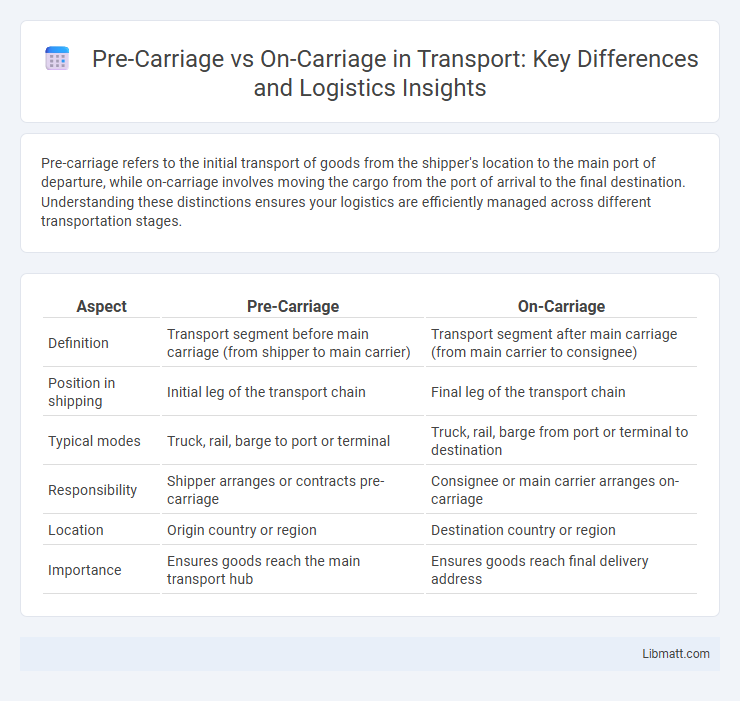Pre-carriage refers to the initial transport of goods from the shipper's location to the main port of departure, while on-carriage involves moving the cargo from the port of arrival to the final destination. Understanding these distinctions ensures your logistics are efficiently managed across different transportation stages.
Table of Comparison
| Aspect | Pre-Carriage | On-Carriage |
|---|---|---|
| Definition | Transport segment before main carriage (from shipper to main carrier) | Transport segment after main carriage (from main carrier to consignee) |
| Position in shipping | Initial leg of the transport chain | Final leg of the transport chain |
| Typical modes | Truck, rail, barge to port or terminal | Truck, rail, barge from port or terminal to destination |
| Responsibility | Shipper arranges or contracts pre-carriage | Consignee or main carrier arranges on-carriage |
| Location | Origin country or region | Destination country or region |
| Importance | Ensures goods reach the main transport hub | Ensures goods reach final delivery address |
Understanding Pre-Carriage and On-Carriage
Pre-carriage refers to the initial transport of goods from the shipper's premises to the port of loading, while on-carriage covers the movement from the port of discharge to the final destination. Effective coordination of both pre-carriage and on-carriage steps is essential for seamless supply chain management, reducing delays and costs. Understanding the distinctions between these transport phases ensures accurate allocation of responsibilities and efficient documentation in international shipping logistics.
Key Differences Between Pre-Carriage and On-Carriage
Pre-carriage refers to the initial transport of goods from the shipper's premises to the main carrier or port, whereas on-carriage involves moving the cargo from the arrival port to the final destination. Your shipping process includes pre-carriage typically handled by trucks or rail before the main sea or air transport, while on-carriage occurs after unloading, ensuring delivery to warehouses or consignees. Understanding these distinctions optimizes logistics planning and accurate cost allocation within your supply chain.
Role of Pre-Carriage in Global Shipping
Pre-carriage plays a critical role in global shipping by ensuring goods are transported from the shipper's premises to the main port of departure, facilitating smooth integration with the international shipping line. It involves modes such as trucking, rail, or inland barge transport, optimizing the supply chain's efficiency before ocean freight begins. Effective pre-carriage minimizes delays and handling risks, contributing to timely delivery and cost savings in the global logistics process.
On-Carriage: Importance in the Supply Chain
On-carriage plays a crucial role in the supply chain by facilitating the final leg of transportation from the port or terminal to the recipient's warehouse or distribution center. Efficient on-carriage ensures timely delivery, reduces transit times, and minimizes handling risks, directly impacting your overall supply chain performance. Understanding on-carriage logistics helps optimize cost and improve customer satisfaction through reliable last-mile delivery solutions.
Common Modes of Transport for Pre-Carriage
Pre-carriage typically involves inland transportation modes such as trucks, trains, or barges to move goods from the shipper's premises to the port of export. Trucking is the most common mode due to its flexibility and door-to-port capabilities, while rail is preferred for long-distance inland hauling with cost efficiency. Barges provide a sustainable option for transporting bulk cargo via inland waterways to major ports.
Typical On-Carriage Transportation Methods
Typical on-carriage transportation methods include trucks, rail, and inland waterways, which move goods from the port of arrival to the final destination. On-carriage plays a crucial role in the supply chain by ensuring efficient last-mile delivery and seamless distribution. Selection of on-carriage mode depends on factors such as cost, distance, cargo type, and delivery urgency.
Pre-Carriage: Challenges and Solutions
Pre-carriage involves transporting goods from the shipper's premises to the port of loading, often facing challenges such as delays due to traffic congestion, documentation errors, and customs clearance complexities. Solutions include implementing advanced tracking technologies, streamlining documentation processes through digital platforms, and collaborating with experienced local carriers to minimize transit times and avoid bottlenecks. Efficient pre-carriage logistics are crucial for maintaining overall supply chain reliability and meeting shipment schedules.
On-Carriage: Risks and Considerations
On-carriage involves the transportation of goods from the destination port to the final consignee, often by truck, rail, or inland waterways, presenting risks such as cargo damage, theft, or delays during inland transit. It requires detailed coordination with reliable carriers and thorough documentation to ensure the seamless transfer of goods after the main ocean freight leg. Proper insurance coverage is essential to mitigate liabilities associated with on-carriage risks, safeguarding the interests of all parties involved in the delivery chain.
How Pre-Carriage and On-Carriage Affect Shipping Costs
Pre-carriage refers to the initial transportation of goods from the supplier's warehouse to the port of origin, while on-carriage involves moving cargo from the destination port to the final delivery point. Shipping costs are influenced by pre-carriage as it can include local trucking, rail, or inland transport charges before ocean freight begins, often impacting overall logistics expenses. On-carriage costs depend on distances, transportation methods, and delivery urgency, potentially increasing the total freight charges beyond the ocean carrier's base rate.
Choosing the Right Logistics Provider for Pre-Carriage and On-Carriage
Selecting the right logistics provider for pre-carriage and on-carriage involves assessing expertise in inland transportation modes such as trucking, rail, or barge to ensure seamless door-to-port and port-to-door movement. Providers with integrated tracking systems and strong local networks improve cargo visibility and minimize delays during these critical first and last mile segments. Evaluating carrier reliability, transit times, and cost efficiency determines optimal coordination between origin and destination points.
pre-carriage vs on-carriage Infographic

 libmatt.com
libmatt.com